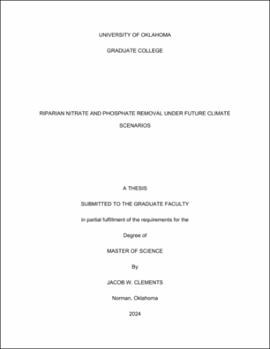| dc.description.abstract | Riparian buffer zones are specially managed zones that lie between agricultural fields and rivers, lakes, or wetlands. They are crucial for protecting water quality, human health, and ecosystem function. Critical ecosystem services of riparian soils include nitrogen removal via denitrification and phosphorus retention through sorption on mineral surfaces. Soil moisture influences these processes by controlling the rate of oxygen diffusion and, therefore, the soil’s redox potential. However, soils are predicted to be drier as climate change progresses, and these changes in soil moisture conditions will alter nitrogen cycle dynamics and phosphorus removal in riparian systems. We conducted a lab experiment to investigate potential changes in riparian ecosystem services brought on by climate change. We hypothesized that climate-induced shifts in moisture dynamics would enhance phosphorus removal but hinder denitrification due to increased oxygen diffusion caused by lower soil moisture conditions. We collected forty-eight soil cores (5 cm diameter, 15 cm height), and we collected additional samples for particle size, bulk density, and powder X-ray diffraction (XRD) analyses. We applied soil treatments in a fully factorial design, considering soil texture (sandy loam versus silty clay loam), antecedent soil moisture (field capacity versus drought), water application (flooding versus capillary rise), and pollutant quantity (simulated agricultural runoff versus deionized water). We primarily performed colorimetric assays on soil porewater and soil samples to determine NO3- and PO43- availability and movement. We also performed elemental analyses to complement the colorimetric assays. Our porewater chemistry and mass balance results showed significant changes in nitrogen cycle dynamics, showing evidence of denitrification, Dissimilatory Nitrate Reduction to Ammonium (DNRA), nitrogen fixation, and nitrogen mineralization. Statistical analyses of the data, primarily through generalized additive mixed-effects models (GAMMs), indicate significant individual and combined positive and negative effects (p<0.05) of the simulated treatments on porewater nitrate, ammonium, and phosphate concentrations, along with porewater pH and ARQ (CO2/O2). Critically, Moisture Regime and Water Application, our two climate proxies, both individually and collectively, significantly affected porewater nitrate, ammonium, and phosphate concentrations. Nitrate porewater concentrations are higher in decreased moisture conditions and changing precipitation as predicted under future climate scenarios. Phosphate porewater concentrations were lower in sandier soils, drought conditions, and capillary rise water application. However, phosphate leached out of the soil during simulated intense precipitation, highlighting the complexities of how predicted climate scenarios will be partially beneficial for phosphate sorption. XRD analysis revealed a mixed clay mineralogy, including a mixed-layer illite-montmorillonite, IS70R1. Additionally, clay mineralogy in clay-rich soil plays a statistically significant role in moderating the soil nitrogen cycle. Correlated extractable iron and nitrogen data indicate evidence of the Ferrous Wheel Hypothesis, especially in temporarily anoxic soils flooded by intense precipitation. Our research demonstrates that future climate scenarios affect key riparian biogeochemical processes and should be researched more thoroughly as the average worldwide temperature climbs above 1.5°C. | en_US |

